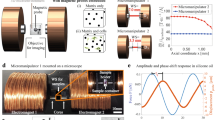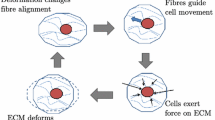Abstract
The extracellular matrix provides macroscale structural support to tissues as well as microscale mechanical cues, like stiffness, to the resident cells. As those cues modulate gene expression, proliferation, differentiation, and motility, quantifying the stiffness that cells sense is crucial to understanding cell behavior. Whereas the macroscopic modulus of a collagen network can be measured in uniform extension or shear, quantifying the local stiffness sensed by a cell remains a challenge due to the inhomogeneous and nonlinear nature of the fiber network at the scale of the cell. To address this challenge, we designed an experimental method to measure the modulus of a network of collagen fibers at this scale. We used spherical particles of an active hydrogel (poly N-isopropylacrylamide) that contract when heated, thereby applying local forces to the collagen matrix and mimicking the contractile forces of a cell. After measuring the particles’ bulk modulus and contraction in networks of collagen fibers, we applied a nonlinear model for fibrous materials to compute the modulus of the local region surrounding each particle. We found the modulus at this length scale to be highly heterogeneous, with modulus varying by a factor of 3. In addition, at different values of applied strain, we observed both strain stiffening and strain softening, indicating nonlinearity of the collagen network. Thus, this experimental method quantifies local mechanical properties in a fibrous network at the scale of a cell, while also accounting for inherent nonlinearity.











Similar content being viewed by others
References
Discher D, Janmey P, Wang Y-L (2005) Tissue cells feel and respond to the stiffness of their substrate. Science 310:1139–1143
Lo CM, Wang HB, Dembo M, Wang YL (2000) Cell movement is guided by the rigidity of the substrate. Biophys J 79(1):144–152
Paszek MJ, Zahir N, Johnson KR, Lakins JN, Rozenberg GI, Gefen A, Reinhart-King CA, Margulies SS, Dembo M, Boettiger D, Hammer DA, Weaver VM (2005) Tensional homeostasis and the malignant phenotype. Cancer Cell 8(3):241–254
Provenzano PP, Inman DR, Eliceiri KW, Trier SM, Keely PJ (2008) Contact guidance mediated three-dimensional cell migration is regulated by rho/rock-dependent matrix reorganization. Biophys J 95 (11):5374–5384
Ulrich TA, de Juan Pardo EM, Kumar S (2009) The mechanical rigidity of the extracellular matrix regulates the structure, motility, and proliferation of glioma cells. Cancer Res 69(10):4167–4174
Riching KM, Cox BL, Salick MR, Pehlke C, Riching AS, Ponik SM, Bass BR, Crone WC, Jiang Y, Weaver AM, Eliceiri KW, Keely PJ (2014) 3D Collagen alignment limits protrusions to enhance breast cancer cell persistence. Biophys J 107(11):2546–2558
Engler AJ, Sen S, Sweeney HL, Discher DE (2006) Matrix elasticity directs stem cell lineage specification. Cell 126(4):677–689
Provenzano PP, Eliceiri KW, Campbell JM, Inman DR, White JG, Keely PJ (2006) Collagen reorganization at the tumor-stromal interface facilitates local invasion. BMC Med 4(1):1
Provenzano PP, Inman DR, Eliceiri KW, Keely PJ (2009) Matrix density-induced mechanoregulation of breast cell phenotype, signaling and gene expression through a fak–erk linkage. Oncogene 28(49):4326–4343
Storm C, Pastore JJ, MacKintosh FC, Lubensky TC, Janmey PA (2005) Nonlinear elasticity in biological gels. Nature 435(7039):191–194
Stein AM, Vader DA, Weitz DA, Sander LM (2011) The micromechanics of three-dimensional collagen-I gels. Complexity 16(4):22–28
Motte S, Kaufman LJ (2013) Strain stiffening in collagen I networks. Biopolymers 99(1):35–46
Notbohm J, Lesman A, Rosakis P, Tirrell DA, Ravichandran G (2015) Microbuckling of fibrin provides a mechanism for cell mechanosensing. J R Soc Interface 12(108):20150320
Vahabi M, Sharma A, Licup AJ, van Oosten AS, Galie PA, Janmey PA, MacKintosh FC (2016) Elasticity of fibrous networks under uniaxial prestress. Soft Matter 12(22):5050–5060
van Oosten AS, Vahabi M, Licup AJ, Sharma A, Galie PA, MacKintosh FC, Janmey PA (2016) Uncoupling shear and uniaxial elastic moduli of semiflexible biopolymer networks: compression-softening and stretch-stiffening. Sci Rep 6:19270
Burkel B, Notbohm J (2017) Mechanical response of collagen networks to nonuniform microscale loads. Soft Matter 13(34):5749–5758
Shokef Y, Safran SA (2012) Scaling laws for the response of nonlinear elastic media with implications for cell mechanics. Phys Rev Lett 108(17):178103
Wang H, Abhilash A, Chen CS, Wells RG, Shenoy VB (2014) Long-range force transmission in fibrous matrices enabled by tension-driven alignment of fibers. Biophys J 107(11):2592–2603
Rosakis P, Notbohm J, Ravichandran G (2015) A model for compression-weakening materials and the elastic fields due to contractile cells. J Mech Phys Solids 85:18–32
Xu X, Safran SA (2015) Nonlinearities of biopolymer gels increase the range of force transmission. Phys Rev E 92(3):032728
Roeder BA, Kokini K, Sturgis JE, Robinson JP, Voytik-Harbin SL (2002) Tensile mechanical properties of three-dimensional type i collagen extracellular matrices with varied microstructure. J Biomech Eng–T ASME 124(2):214–222
Janmey PA, McCormick ME, Rammensee S, Leight JL, Georges PC, MacKintosh FC (2007) Negative normal stress in semiflexible biopolymer gels. Nat Mater 6(1):48–51
Brown AE, Litvinov RI, Discher DE, Purohit PK, Weisel JW (2009) Multiscale mechanics of fibrin polymer: gel stretching with protein unfolding and loss of water. Science 325(5941):741–474
Vader D, Kabla A, Weitz D, Mahadevan L (2009) Strain-induced alignment in collagen gels. Plos One 4(6):e5902
Münster S., Jawerth LM, Leslie BA, Weitz JI, Fabry B, Weitz DA (2013) Strain history dependence of the nonlinear stress response of fibrin and collagen networks. P Natl Acad Sci USA 110(30):12197–12202
Kim OV, Litvinov RI, Weisel JW, Alber MS (2014) Structural basis for the nonlinear mechanics of fibrin networks under compression. Biomaterials 35(25):6739–6749
Kurniawan NA, Wong LH, Rajagopalan R (2012) Early stiffening and softening of collagen: interplay of deformation mechanisms in biopolymer networks. Biomacromolecules 13(3):691–698
Lin DC, Shreiber DI, Dimitriadis EK, Horkay F (2009) Spherical indentation of soft matter beyond the hertzian regime: numerical and experimental validation of hyperelastic models. Biomech Model Mechan 8(5):345–358
Velegol D, Lanni F (2001) Cell traction forces on soft biomaterials. I. microrheology of type I collagen gels. Biophys J 81(3):1786–1792
Kotlarchyk MA, Shreim SG, Alvarez-Elizondo MB, Estrada LC, Singh R, Valdevit L, Kniazeva E, Gratton E, Putnam AJ, Botvinick EL (2011) Concentration independent modulation of local micromechanics in a fibrin gel. Plos One 6(5):e20201
Shayegan M, Forde NR (2013) Microrheological characterization of collagen systems: from molecular solutions to fibrillar gels. Plos One 8(8):e70590
Jones CA, Cibula M, Feng J, Krnacik EA, McIntyre DH, Levine H, Sun B (2015) Micromechanics of cellularized biopolymer networks. P Natl Acad Sci USA 112(37):E5117–E5122
Koch TM, Münster S, Bonakdar N, Butler JP, Fabry B (2012) 3D traction forces in cancer cell invasion. Plos One 7(3):e33476
Lesman A, Notbohm J, Tirrell D, Ravichandran G (2014) Contractile forces regulate cell division in three-dimensional environments. J Cell Biol 205(2):155–162
Notbohm J, Lesman A, Tirrell DA, Ravichandran G (2015) Quantifying cell-induced matrix deformation in three dimensions based on imaging matrix fibers. Integr Biol 7(10):1186–1195
Owen LM, Adhikari AS, Patel M, Grimmer P, Leijnse N, Kim MC, Notbohm J, Franck C, Dunn AR (2017) A cytoskeletal clutch mediates cellular force transmission in a soft, three-dimensional extracellular matrix. Mol Biol Cell 28(14):1959–1974
Grimmer P, Notbohm J (2018) Displacement propagation in fibrous networks due to local contraction. J Biomech Eng 140(4): 041011
Eshelby JD (1959) The elastic field outside an ellipsoidal inclusion. P Roy Soc Lond A Mat 252(1271):561–569
Burkel B, Proestaki M, Tyznik S, Notbohm J (2018) Heterogeneity and nonaffinity of cell-induced matrix displacements. Phys Rev E 98(5):052410
Raub C, Putnam A, Tromberg B, George S (2010) Predicting bulk mechanical properties of cellularized collagen gels using multiphoton microscopy. Acta Biomater 6(12):4657–4665
Lopez-Garcia MdC, Beebe D, Crone W (2010) Mechanical interactions of mouse mammary gland cells with collagen in a three-dimensional construct. Ann Biomed Eng 38(8):2485–2498
Burkel B, Morris BA, Ponik SM, Riching KM, Eliceiri KW, Keely PJ (2016) Preparation of 3D collagen gels and microchannels for the study of 3D interactions in vivo. J Vis Exp (111), e53989
Yeung T, Georges PC, Flanagan LA, Marg B, Ortiz M, Funaki M, Zahir N, Ming W, Weaver V, Janmey PA (2005) Effects of substrate stiffness on cell morphology, cytoskeletal structure, and adhesion. Cell Motil Cytoskel 60(1):24–34
Sierra-Martin B, Laporte Y, South AB, Lyon LA, Fernandez-Nieves A (2011) Bulk modulus of poly (N-isopropylacrylamide) microgels through the swelling transition. Phys Rev E 84(1): 011406
Voudouris P, Florea D, van der Schoot P, Wyss HM (2013) Micromechanics of temperature sensitive microgels: dip in the poisson ratio near the lcst. Soft Matter 9(29):7158–7166
Licup AJ, Münster S, Sharma A, Sheinman M, Jawerth LM, Fabry B, Weitz DA, MacKintosh FC (2015) Stress controls the mechanics of collagen networks. P Natl Acad Sci USA 112(31):9573–9578
Yang Y-l, Leone LM, Kaufman LJ (2009) Elastic moduli of collagen gels can be predicted from two-dimensional confocal microscopy. Biophys J 97(7):2051–2060
Feng J, Levine H, Mao X, Sander LM (2015) Alignment and nonlinear elasticity in biopolymer gels. Phys Rev E 91(4):042710
Stout DA, Bar-Kochba E, Estrada JB, Toyjanova J, Kesari H, Reichner JS, Franck C (2016) Mean deformation metrics for quantifying 3d cell–matrix interactions without requiring information about matrix material properties. P Natl Acad Sci USA 113(11):2898–2903
Nam S, Lee J, Brownfield DG, Chaudhuri O (2016) Viscoplasticity enables mechanical remodeling of matrix by cells. Biophys J 111(10):2296–2308
Nam S, Hu K, Butte M, Chaudhuri O (2016) Strain-enhanced stress relaxation impacts nonlinear elasticity in collagen gels. P Natl Acad Sci USA 113(20):5492–5497
Velegol D, Lanni F (2001) Cell traction forces on soft biomaterials. I. Microrheology of type I collagen gels. Biophys J 81(3):1786–1792
Kotlarchyk MA, Shreim SG, Alvarez-Elizondo MB, Estrada LC, Singh R, Valdevit L, Kniazeva E, Gratton E, Putnam AJ, Botvinick EL (2011) Concentration independent modulation of local micromechanics in a fibrin gel. Plos One 6(5):1–12
Hu X, Margadant FM, Yao M, Sheetz MP (2017) Molecular stretching modulates mechanosensing pathways. Protein Sci 26(7):1337–1351
Maniotis AJ, Chen CS, Ingber DE (1997) Demonstration of mechanical connections between integrins, cytoskeletal filaments, and nucleoplasm that stabilize nuclear structure. P Natl Acad Sci USA 94(3):849–854
Cho S, Irianto J, Discher DE (2017) Mechanosensing by the nucleus: from pathways to scaling relationships. J Cell Biol 216(2):305–315
Kirby TJ, Lammerding J (2018) Emerging views of the nucleus as a cellular mechanosensor. Nat Cell Biol 20:373–381
Acknowledgments
We thank the Materials Science Center at the University of Wisconsin–Madison, which provided access to the spinning disk confocal microscope. This work was supported in part by NIH NCI P30CA014520–UW Comprehensive Cancer Center Support Grant and National Science Foundation grant number CMMI-1749400.
Author information
Authors and Affiliations
Corresponding author
Additional information
Publisher’s Note
Springer Nature remains neutral with regard to jurisdictional claims in published maps and institutional affiliations.
Rights and permissions
About this article
Cite this article
Proestaki, M., Ogren, A., Burkel, B. et al. Modulus of Fibrous Collagen at the Length Scale of a Cell. Exp Mech 59, 1323–1334 (2019). https://doi.org/10.1007/s11340-018-00453-4
Received:
Accepted:
Published:
Issue Date:
DOI: https://doi.org/10.1007/s11340-018-00453-4




